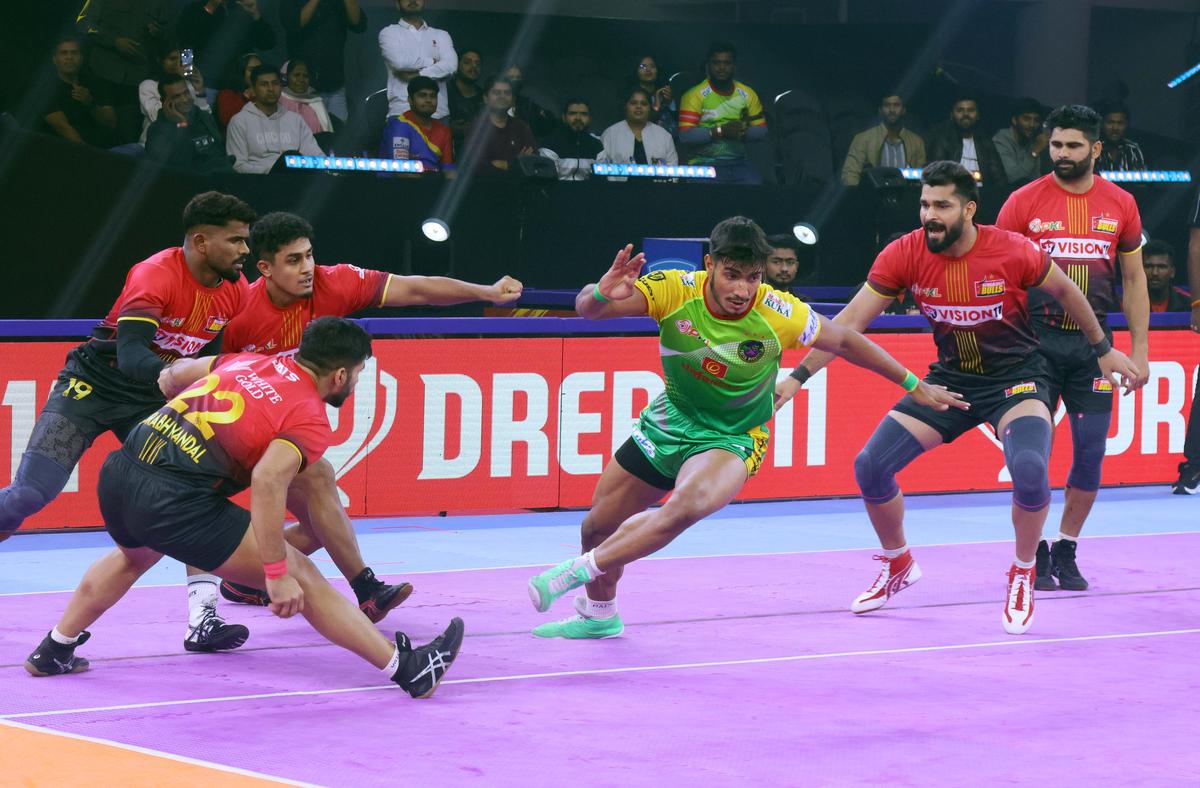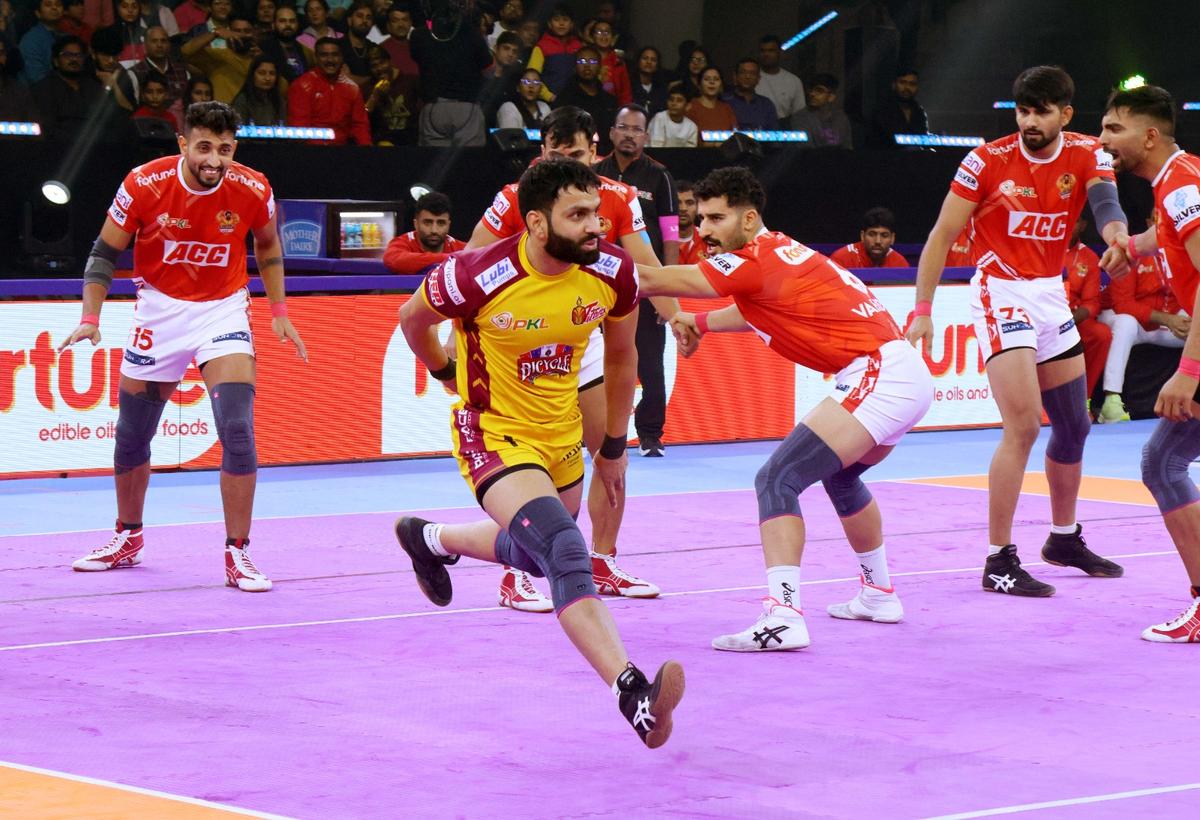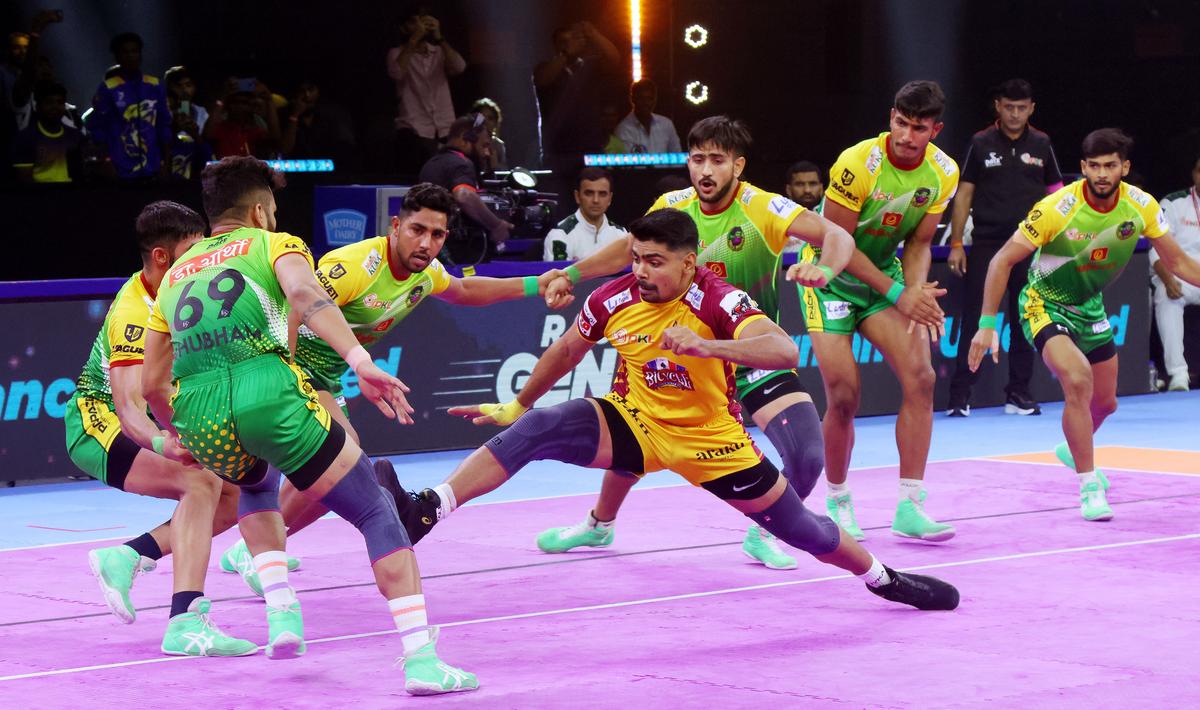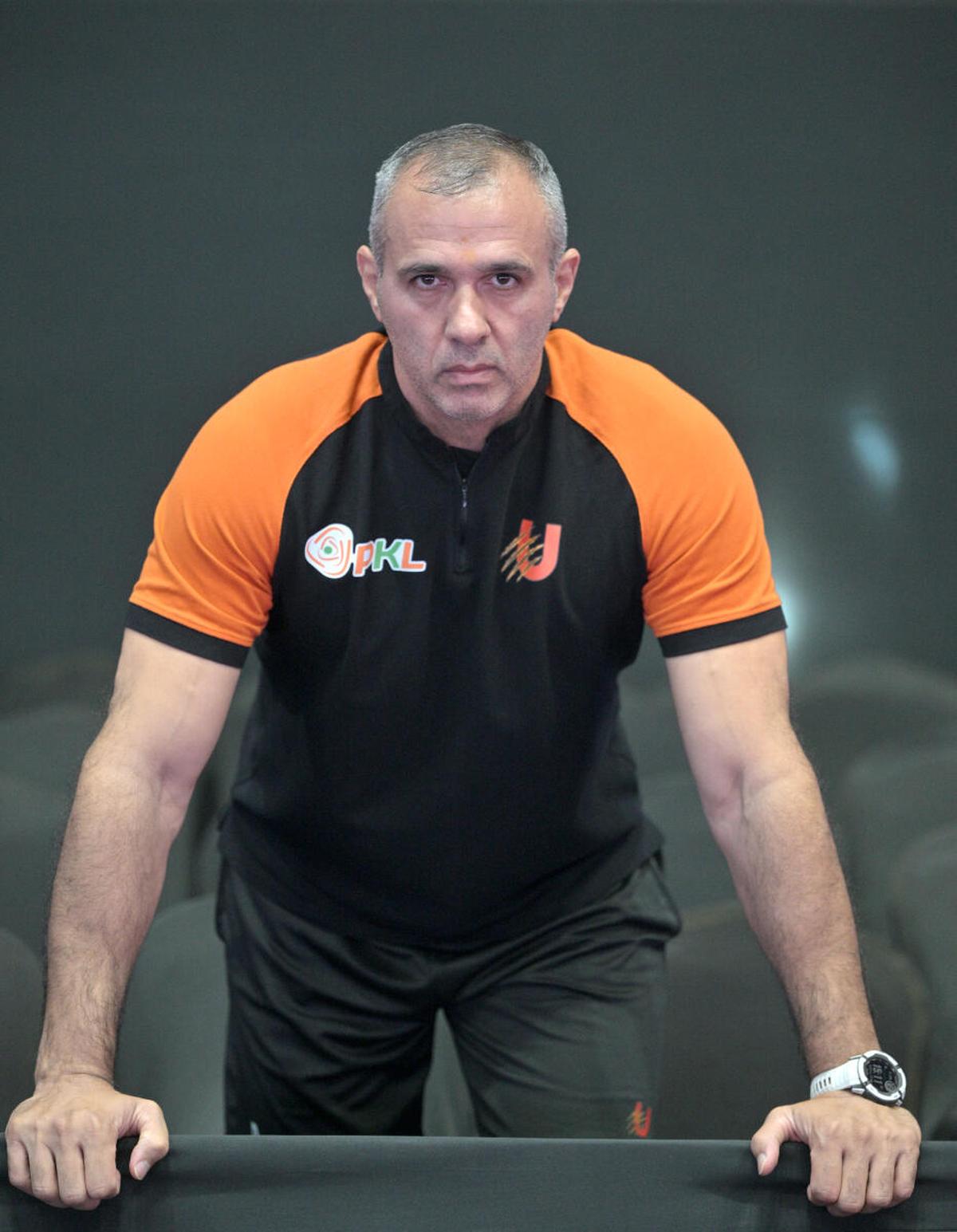Pro Kabaddi League – A decade of deliverance, but what’s next for PKL?
In 2010, young men in Bijnor, Uttar Pradesh, particularly those inclined towards sports, had two main career paths before them: joining the Armed Forces or the Police. This was true for much of the country, where budding athletes often looked to the Services for secure jobs along with the option of continuing to play sport. Rahul Chaudhari was no exception. A skilled athlete who wasn’t particularly interested in academics (despite an aptitude for maths), Chaudhari found joy in sport, especially kabaddi.
“ Par haath, pair toot gaye toh? (What if you break your limbs?),” his father would often say, admonishing him, especially for playing the sport he would later become synonymous with. Like many kabaddi players before and after him, Chaudhari came from a farming family, where seeking work outside agriculture was considered unconventional.
“We would look for jobs that offered 40-50,000 rupees a month. With that, you had to manage not only your family commitments but also dedicate resources to diet and training. Kabaddi is fortunate to have an entity like Pro Kabaddi League (PKL). Otherwise, players would never be in a position to give this sport their all,” Chaudhari tells Sportstar.
ALSO READ | ‘I want to be remembered as a good person, not just a good player’ – Fazel Atrachali
He recalls a time when he sought out tournaments in nearby districts that offered a Bullet motorcycle as the prize for the top raider. “I had enough confidence to seek these competitions out because I knew I was going to come back with that bike.”
That love eventually grew into a love for cars.
“I built a house with the money I earned from PKL. I got my brothers married and funded my own wedding. And yes, I got my share of cars. I bought an Audi. My father asked me why I was wasting money, but I told him I’ve worked hard for it. Meri bhi koi life hai (It’s my life too).”
Rahul Chaudhari became a household name and eventually the league’s poster boy. His imperious performances earned him the title of ‘Showman’.
| Photo Credit:
PKL
Rahul Chaudhari became a household name and eventually the league’s poster boy. His imperious performances earned him the title of ‘Showman’.
| Photo Credit:
PKL
A step up the economic ladder
The star raider’s prolific career has coincided with the birth and growth of the PKL. Modelled on the Indian Premier League (IPL), the PKL turned a rustic, relatively raw maati se juda hua khel (sport of the soil) into a hit television product.
For E. Prasad Rao, PKL’s technical director, seeing players like Chaudhari, Aslam Inamdar (Puneri Paltan’s PKL-winning captain), Siddharth Desai (a towering raider with Telugu Titans), and many others benefit financially from the league was one of two primary objectives.
“When we started PKL, the highest amount a player earned was ₹12 lakh, and we were incredibly happy with that,” Rao remembers. “Now, that’s what our junior-most players are getting. Some used that money to get a house, support their family, or even purchase a buffalo. It was big money, but they didn’t spend it on themselves. That’s what has changed over time. Players are now able to do all of the above while also spending on their own development — hiring trainers, physiotherapists, dieticians, and more.”
“While more international fixtures would undoubtedly help elevate kabaddi’s global stature, PKL serves as a critical platform for developing and nurturing talent that feeds into the national team ”Anupam Goswami, Business Head, Mashal Sports & League Chairman, PKL
The 2014 edition of PKL began with eight franchises, growing to 10 by 2017. League officials envision further expansion in the years to come, though those plans are yet to take shape. In the decade that has passed in PKL’s life cycle, Rao believes that a key objective — potentially even the most binding one — has been fulfilled.
ALSO READ | From Kickboxing to Kabaddi: U Mumba raider Ajit Chouhan’s rise in PKL 11
From strength to speed
“Look at cricket. Eighty per cent of the population that loves this game doesn’t play it but stays connected in one way or another. Our biggest goal was to bring kabaddi to the common man in a similar manner. It’s our own sport, born in India. Everyone here understands the basics of the game. Maybe some specific rules might be hard at first. But it never managed to carve a space in people’s hearts. The game inherently has an excitement we needed to tap. The message we wanted to convey was to make people realise that such a fierce game is our own,” he says.
Chaudhari was the young blood when the league began 10 years ago. Before him came legends like Anup Kumar, Rakesh Kumar, and Iran’s Meraj Sheykh, who were the faces of the sport just after the turn of the millennium. Stellar performances, title wins, and a game whose international shape and format were tweaked to cater to a television audience reaped massive benefits for the league. It eventually became the second-most watched sporting league in the country, after the IPL.

Rising star: Devank (centre) has made heads turn this season by topping the raiding charts ahead of established names like Pawan Sehrawat, Ashu Malik and Arjun Deshwal.
| Photo Credit:
PKL
Rising star: Devank (centre) has made heads turn this season by topping the raiding charts ahead of established names like Pawan Sehrawat, Ashu Malik and Arjun Deshwal.
| Photo Credit:
PKL
Chaudhari, donning the yellow of the Telugu Titans, became a household name and eventually the league’s poster boy. It helped that the raider carried oodles of spunk and an almost arrogant confidence, often taking difficult games by the neck and turning them in his team’s favour. His imperious performances earned him the title of ‘Showman’ — he was the league’s first superstar.
“For me, the PKL trophy was the one jewel missing from a crown that had everything else. Despite the Asian Games medal, World Cup medal, and national titles, I would get asked, ‘PKL kabhi jeete? (Have you won PKL?’ All my achievements aside, it was the one trophy I didn’t have that stood out.”
ALSO | Pro Kabaddi League 11: Ashu Malik anointed a leader for future
Years past his prime in the PKL, when raiding opportunities were few and far between, Chaudhari — now in the Jaipur Pink Panthers’ colours — finally won the PKL trophy in 2022. Team owner Abhishek Bachchan famously proclaimed, “From season 1, he has been putting in the effort to make a name for himself, so this title is for him.”
The youngster who once just wanted to play his favourite sport on TV had finally earned his flowers, at a stage in his career when the league’s market had deemed him past his sell-by date. Ten years on, the realities of sport took over. He went unsold in the auction ahead of the ongoing 11th season and soon announced his retirement. His ‘showman’ title has passed on to another spunky, hotheaded superstar, Iranian allrounder Mohammad Mohammadreza Shadloui Chiyaneh.
“Look at the generations of players coming through. It’s not only about player exposure and confidence; it’s also about player height and weight. Now kabaddi has become about speed and agility instead of the earlier focus on brute strength,” he explains.
Balancing faith with the market
Rao says the fact that defenders now fetch as much money as raiders — something he likens to how bowlers are now valued just as much as batters in the IPL — is also due to this shift. Earlier, raiding was considered the more glamorous skill. Today, a large chunk of players sees a higher value in being all-rounders. Pawan Sehrawat, the Indian captain and easily among the nation’s smartest raiders, often doubles up in defence. This sets him apart and gives him an edge over an old-school muscle man-raider like Maninder Singh. Inamdar, Mohit Goyat. Even the league’s latest raiding sensations, Devank (Patna Pirates) and Sushil Kambrekar (Bengal Warriorz), are handy in the backline.
Arjun Deshwal.
| Photo Credit:
SHASHI SHEKHAR KASHYAP
Arjun Deshwal.
| Photo Credit:
SHASHI SHEKHAR KASHYAP
Team dynamics have also evolved over the decade. Teams have had to balance faith in players and build personalities who can define their brand of kabaddi with actual performances on the mat. Warriorz have persisted with Maninder despite the ups and downs that come through in his season’s raiding trajectory. Pune has built its brand around a core of five homegrown academy-developed youngsters who took the side to its maiden title in 2023.
Apurv Gupta, CEO of the Warriorz, calls it a chicken-and-egg situation.
“Maninder is Bengal Warriorz, and Bengal Warriorz is Maninder in some shape or form. That’s the kind of association we want to build with a player,” he explains. “We want to bring in players, have long-term associations with them, groom them, and build the brand around them.” This, of course, has been a formula we’ve seen generate rich dividends in the IPL. The Pandya brothers and Ishan Kishan with Mumbai Indians, Yashasvi Jaiswal with Rajasthan Royals, and Chennai Super Kings sticking to tried and tested talents are just a few examples.
“A lot goes on behind the scenes. People see and evaluate a player based on just the 22 matches they play. But whether he was playing through pain, or whether his performance dipped for any other reason, these are all factors we consider. Good or bad seasons sometimes don’t dictate the players we back,” Gupta elaborates.
“Regular broadcasting is a necessity for domestic tiers of the game. With the talent pool widening, fans should have more opportunities to discover and follow new players ”Rishank Devadiga, U Mumba raider
Kailash Kandpal, CEO of the Puneri Paltan, credits this frustration for fast-tracking the establishment of the franchise’s academy in Thane, which has produced championship-winning players for the side. “If you look at acquiring players from the auction, you barely get a few weeks to know the player and build team patterns around them. We can’t hold players for long. Retention policies eased those stresses a bit, but we still have a long way to go there. Most of the boys you see now have been with us since season eight, but these are academy-groomed players rather than pure scouting acquisitions,” he explains. Kandpal, however, does stress that the return on investment is quite small in terms of the number of players an academy can fashion into stars. He calls Inamdar and Goyat, the star duo of the Paltan, outliers rather than the norm, which makes kinder retention rules even more important.
Suhail Chandhok, CEO of U Mumba, is into his second season in the role after calling the game on broadcast since the league’s inception. His entrepreneurial ventures into the sport involved setting up the Yuva Kabaddi Series and several other grassroots initiatives to churn talent for higher levels of the sport. He finds the current auction structure antithetical to the tendency franchises have. “Job security is one of the biggest anxieties players carry in this league. But the biggest problem, and the biggest frustration for me and many other team owners, is that when we sign a player, there’s no guarantee that we will have this player for the next five years. As franchises, we might invest in Arjun Deshwal (right), Abhishek Singh, or Siddharth Desai, but in two years’ time, they could well be floating off to another team. The league needs to address this.
Fazel Atrachali, PKL’s all-time top defender
| Photo Credit:
SHASHI SHEKHAR KASHYAP
Fazel Atrachali, PKL’s all-time top defender
| Photo Credit:
SHASHI SHEKHAR KASHYAP
“Locking players down and building teams and systems around them has commercial value for the outfit and the fan base. Look at what Anup Kumar and legendary Iranian defender Fazel Atrachali (facing page) commanded at U Mumba. The youngsters coming through will also do that, but where is the guarantee? Where is the security for the investment I am making in that player? PKL is the second-biggest sporting league in the country, it’s time we act like it and evolve from the patterns of the first decade. Long-term contracts, trading windows, player policies, exit clauses for teams to also be secure should all be on the table,” he adds.
ALSO READ | Mohammadreza Shadloui becomes fastest to reach 300 tackle points in PKL history
Globalisation in limbo
While the COVID-19 pandemic emerged as a massive curveball to the sporting world as a whole, kabaddi and the PKL made a strong statement of intent by becoming the first contact sport to conduct a full-fledged league during the pandemic, albeit behind closed doors.
That said, inconsistencies in the sport’s global scene predate the COVID era. World Cups sometimes come with gaps of over 8-10 years. Fazel told this publication a few years ago that the lack of robustly scheduled tournaments had robbed him of medals he would have otherwise definitely won. This season,he is more cynical at the mention of a scheduled world event in 2025. “I’ll believe it when it happens,” he said.
For franchises in the PKL, the bigger concern is having a player pool that has nothing to do outside of the domestic structure for nine months outside the league’s duration. “The longevity, I mean, two to two-and-a-half months of the league and then, you know, not being present for nine months is something that needs to be solved, either by the league, the franchisees, or as a collective,” Gupta says.
Paltan does that with its Yuva Paltan participating in age-group leagues. UP Yoddhas is exploring the academy approach that Paltan has patented. Telugu Titans, Mumba and Tamil Thalaivas have often supported local tournaments to blood talent but are yet to either develop academy structures or get their main squad into competitive patterns outside the PKL.
Breaking the duopoly
Chandhok believes that a blanket expectation of more international tournaments does no good when the only two competitive teams are India and Iran.
“What are you going to gain from playing an eight-nation or a 10-nation tournament where you’re just waiting for an India-Iran match? I can understand why you’re not pushing hard to keep doing international tournaments when you might as well just do a bilateral series and be done with it.”

On the bright side: This season, Telugu Titans have seen a young bunch, under the able leadership of vice-captain Vijay Malik (centre), give an encouraging account of themselves.
| Photo Credit:
PKL
On the bright side: This season, Telugu Titans have seen a young bunch, under the able leadership of vice-captain Vijay Malik (centre), give an encouraging account of themselves.
| Photo Credit:
PKL
It doesn’t help that the Amateur Kabaddi Federation of India finds itself in all kinds of trouble. Despite a completed election and a declared winner, the court-appointed administrator continues to command the federation. This led to a blanket ban on Indian teams from tournaments like the first Senior Men’s World Beach Kabaddi Championships in September, among a few others.
“I hope the handover happens so we’re able to work with the federation and share our thoughts,” Chandhok appeals.
He believes that cricket has lessons here too for kabaddi, and there is scope to develop an ecosystem that goes beyond pinning its hopes for solid competition at just the senior nationals.
“Kabaddi does not have an equivalent of a Ranji Trophy or a Syed Mushtaq Ali Trophy. There are no bilaterals. Cricket has so much outside the IPL. We have the Nationals and Junior Nationals that aren’t televised robustly. All of this needs work. We need to have an open policy with distributing highlights, so these tiers of the sport are seen. Exclusivity can come once the audience is captured as proper investors. Yuva Kabaddi has been building that, and we’re getting there step by step. There’s also the tangible contribution of supplying more than 90 scouted talents to the PKL. That’s the big dog, the elite level. But the support is really needed at the bottom.”
“When we are not delivering, then the excitement or visibility drops, leading to a significant revenue decline. That’s not a sustainable path for any organisation”Trinadh Reddy, CEO, Telugu Titans
Regional focus
The league, after going through the 12-city rigmarole last season, has returned to a three-venue set-up this time with a two-fold motive. Not only does this drastically reduce operational costs, but players also have to travel less and maintain steadier playing and recovery patterns. The league is also able to generate continuous kabaddi action without break days every week, which it hopes will reflect in broadcast numbers.
Hyderabad, Noida and Pune were the chosen venues this time, with two hotbeds of kabaddi, namely the Haryana-Punjab-UP belt and the Maharashtra belt, given priority. Other strongholds of the sport, like Tamil Nadu, missed out.
Gupta believes this is also the case for Bengal but says that much more can be done than just wait for the league to be held there for three weeks. “Bengal used to be a very strong market for kabaddi in the 70s and 80s. Some of the best players have come from there, but it has gone through its own turbulent times.
ALSO READ | Ashok Shinde: The architect of Puneri Paltan’s Pro Kabaddi revolution
“The sport in the 90s and probably the early 2000s sort of dwindled. As a franchise, one of the top priorities on our vision board is to revive that culture here. COVID did not help, as it was a lost opportunity to engage the fan base For us, drawing local talent and forming partnerships with local establishments for tournaments or scouting exercises are one way to fill that gap without the luxury of hosting it ourselves,” he says.

All-rounder: Pawan Sehrawat (centre), the Indian captain and easily among the nation’s smartest raiders, often doubles up in defence.
| Photo Credit:
PKL
All-rounder: Pawan Sehrawat (centre), the Indian captain and easily among the nation’s smartest raiders, often doubles up in defence.
| Photo Credit:
PKL
Academies are another route into the heart of the market. “Anupam Goswami, the league commissioner, once conducted a workshop with all franchises where he took us to the UK to a few football academies to study how youth setups work there. It helped give these ideas in our minds some realistic shape and a glimpse into what some of the ground-level challenges could be too,” says Kandpal.
Star dynamics
Few understand the power of fan bases like Telugu Titans do. The franchise and its fans have learned one of the harshest lessons of the sporting market: a single player, however big a star they may be, cannot guarantee championship silverware.
The Titans have had the choicest picks over the years and a loyal base that unconditionally backed them through thick and thin. Chaudhari, Siddharth, and Pawan have all donned the Titans yellow, but a title is yet to come. With Chaudhari in the mix, they came close, making the playoffs. But since then, the Titans have largely languished in the depths of the table’s bottom half.
Siddharth, their once-imperious raider, faded away under the pressure of carrying the team on his shoulders. Injury troubles with Pawan were an issue last time and this time too. But in 2024, the Titans have seen a young bunch, under the able leadership of vice-captain Vijay Malik, give an encouraging account of themselves. The side is currently placed second with a solid chance of making the playoffs once more.
“Having a star player in the team brings many advantages. Primarily, they have the ability to turn the table at the right moment, and that too single-handedly. They also nurture, shape and elevate the overall performance of the team. So, if the captain, the superstar, does well, there will definitely be an impact on the overall performance of the team and on the brand itself,” says Titans CEO Trinadh Reddy, standing by the franchise’s decisions to keep pursuing these one-man armies to bolster his squad season after season. “There is pressure, but that’s what separates the players from the stars.”
A separate window
Another crucial aspect of stability for fans, along with long-standing stars and a consistent brand of play, is a marked window for the league. The IPL has a set window in the year. The Indian Super League (ISL), Indian football’s top tier, also has a marked duration. ‘Why not for kabaddi,’ Chandhok asks.
“Look at the ISL. They have a set window, and it does not matter whether the Indian cricket team is playing Australia, whether there’s a World Cup, or whether there’s anything else. The ISL window is the ISL window. So, why isn’t there a kabaddi window? That July-August-September chunk that kabaddi had once was a solid space as it gave sponsors the ability to tap into a part of the calendar when not much cricket was going on. This is an indoor sport, and a monsoon window is the perfect time to slot this in for commercial value. Making that stable gives sponsors time to plan for it ahead of time too,” he adds, taking into account the reasonable adjustments that can be made in years when the Asian Games or the Olympics are on.
“All teams struggle a bit when it’s an end-of-year window as sponsors have exhausted their purses elsewhere and don’t have marketing funds to give us.”
ALSO READ | Swapping AFL for kabaddi – Josh Kennedy takes centre stage as PKL gears up for Melbourne sojourn
Fostering a meritocracy
A decade is a great time to look both within and beyond.
As far as expansion goes, for several franchises, like the Warriorz who have interests in other leagues including cricket, a women’s variant of the PKL is high on the to-do list. Gupta was part of the Star Sports team involved in organising the Women’s Kabaddi Challenge, exhibition matches held before the PKL games, much like the now-defunct Women’s T20 Challenge ahead of the IPL.

Gholamreza Mazandarani, U Mumba coach, has been entrusted with figuring out long-term talent development at the club. It’s a path teams are increasing finding the courage to back to create distinct brands in the ecosystem.
| Photo Credit:
Shashi Shekhar Kashyap
Gholamreza Mazandarani, U Mumba coach, has been entrusted with figuring out long-term talent development at the club. It’s a path teams are increasing finding the courage to back to create distinct brands in the ecosystem.
| Photo Credit:
Shashi Shekhar Kashyap
“This is very close to our heart. We’ve seen local tournaments where women’s games are followed and attended much more than men’s games. At the state and national level, there are no differences in organisation. But yes, it does need that jump to the league ecosystem,” he adds, hoping to see something emerge for the growing domestic and international pool of women players in the sport.
Trinadh reveals that the franchise wants to begin with a tournament at least within the Telugu-speaking states and believes that could be a different approach to building on the appetite for women’s sport in India at the moment. Chandhok also believes that a constant dissatisfaction with the product can help foster innovation continuously for an increasingly demanding audience.
While PKL came in with a simplified and television-friendly playing format, the one major change to the way the sport is played was the lobby rule change that was implemented a few seasons ago. Under the old rule, if a raider entered the lobby without touching a defender, or a defender followed the raider into the lobby, both would be sent to the bench. The tweak protected defenders, with the passage of play ending when the raider was eliminated.
However, a defender who was completely out of the mat, with no part of the body remaining, would be out. Still, there have been multiple cases where players, who were within the peripheries of the playing area, were benched due to a lack of contact with the surface, giving rise to contentious calls and enraged debates among players, coaches and fans.
Chandhok says, “We still don’t have clarity on the rules, for example, when a player enters the midline from outside the lobby. There’s each interpretation of that rule; every day your guess is as good as mine. And I think many teams are having matches won or lost on the basis of that single rule.”
More professionalism can foster better results for the sport. Data can help that too. “I’d like to see heat mapping, heart rate monitors, data collection on raiding styles and defensive tendencies, which can add to the conversations around, and decisions made for the sport.” ”



